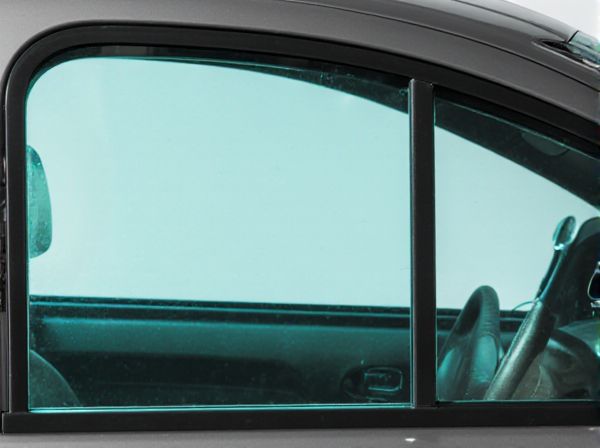
Photo illustration: UV-Cut Glass vs Regular Glass
UV-cut glass blocks harmful ultraviolet rays, protecting your skin and preventing interior fading, while regular glass allows most UV radiation to pass through. This makes UV-cut glass ideal for windows, sunglasses, and protective lenses where UV protection is essential. Choosing UV-cut glass enhances comfort and safety by reducing UV exposure indoors.
Table of Comparison
| Feature | UV-Cut Glass | Regular Glass |
|---|---|---|
| UV Protection | Blocks up to 99% of UV rays | Minimal UV blocking |
| Heat Reduction | Reduces heat transmission | No heat reduction |
| Interior Fading | Prevents fading and damage | Does not prevent fading |
| Cost | Higher initial cost | Lower cost |
| Visibility | Clear visibility with UV protection | Clear visibility only |
Introduction to UV-Cut Glass and Regular Glass
UV-Cut glass is specially designed to block harmful ultraviolet (UV) rays, typically filtering out UV radiation below 400 nanometers to protect interiors and skin from damage. Regular glass, such as standard soda-lime glass, allows a significant portion of UV light, especially UVA and UVB rays, to pass through, potentially causing fading of furnishings and increased risk of skin harm. The key difference lies in the UV absorption properties, with UV-Cut glass incorporating coatings or treatments that enhance its ability to absorb and reflect UV radiation effectively.
Understanding UV Radiation and Its Effects
UV-Cut glass blocks up to 99% of harmful ultraviolet radiation, particularly UV-A and UV-B rays, which contribute to skin aging, eye damage, and material degradation. Regular glass typically filters out most UV-B but allows a significant amount of UV-A to pass through, increasing exposure risks. Understanding the differences in UV radiation transmission highlights the protective benefits of UV-Cut glass in reducing long-term health and property damage.
Composition and Manufacturing Differences
UV-Cut glass incorporates a special coating or additive layer that blocks ultraviolet (UV) radiation, typically made from metal oxides such as titanium dioxide or cerium oxide, whereas regular glass primarily consists of silica with basic additives and lacks UV-blocking properties. The manufacturing of UV-Cut glass involves an extra step, including chemical vapor deposition or sputtering to apply the UV-blocking coating onto the glass surface, contrasting with regular glass production, which typically involves melting and molding silica-based raw materials without additional coatings. These compositional and processing differences enable UV-Cut glass to filter harmful UV rays effectively, enhancing protection for interiors and occupants against UV damage.
How UV-Cut Glass Works
UV-cut glass incorporates a specialized coating or embedded materials that absorb and block ultraviolet (UV) rays, preventing harmful UV radiation from passing through the glass while maintaining visible light transmission. This technology protects interiors from UV-induced fading and reduces potential skin damage by filtering out UV wavelengths typically between 280 and 400 nanometers. Unlike regular glass, which allows a significant portion of UV radiation to penetrate, UV-cut glass provides enhanced protection by specifically targeting these harmful rays without compromising clarity or durability.
Key Benefits of UV-Cut Glass
UV-Cut glass significantly reduces up to 99% of harmful ultraviolet (UV) rays, protecting skin and preventing interior fading compared to regular glass. It enhances energy efficiency by lowering heat transmission, which helps maintain cooler indoor temperatures and reduce air conditioning costs. This type of glass also improves overall comfort and safety by minimizing UV radiation exposure while maintaining clarity and durability.
Common Uses for UV-Cut Glass vs Regular Glass
UV-Cut glass is commonly used in automotive windows, eyewear lenses, and architectural applications to block harmful ultraviolet rays, enhancing protection and comfort. Regular glass is typically used in windows, picture frames, and everyday household items where UV protection is not a priority. UV-Cut glass is preferred in environments requiring UV radiation reduction to prevent fading, skin damage, and heat buildup, while regular glass serves general transparency and visibility purposes.
Durability and Longevity Comparison
UV-Cut Glass offers superior durability compared to regular glass due to its specialized coating that resists scratches, cracks, and environmental wear more effectively. This enhanced protective layer not only blocks harmful ultraviolet rays but also extends the lifespan of the glass by reducing degradation caused by prolonged sun exposure. Regular glass lacks this protective feature, making it more susceptible to damage and aging, resulting in a shorter longevity span.
Cost Analysis: UV-Cut Glass vs Regular Glass
UV-cut glass typically costs 20-30% more than regular glass due to its specialized coating that blocks harmful ultraviolet rays, increasing production complexity. Although the upfront investment is higher, UV-cut glass can reduce long-term expenses by protecting interiors from UV damage, decreasing fading of furniture and reducing cooling costs. Regular glass is more affordable initially but lacks the protective benefits, potentially leading to higher maintenance and replacement costs over time.
Environmental Impact and Sustainability
UV-Cut glass significantly reduces harmful ultraviolet radiation penetration, which helps protect indoor environments and reduces damage to furniture and textiles, thereby extending their lifespan and lowering waste. Its manufacturing process often incorporates environmentally friendly materials and technologies aimed at minimizing carbon emissions compared to traditional regular glass production. By improving energy efficiency through better insulation and UV protection, UV-Cut glass contributes to reduced reliance on artificial cooling, promoting sustainable building practices and lowering overall environmental footprint.
Choosing the Right Glass for Your Needs
UV-cut glass blocks up to 99% of harmful ultraviolet rays, protecting interiors from UV damage and reducing fading on furniture, artwork, and fabrics. Regular glass offers basic transparency but lacks effective UV protection, making it less suitable for sun-exposed spaces requiring skin and material safety. Selecting UV-cut glass enhances durability and comfort in environments with high sunlight exposure, while regular glass remains a cost-effective choice for areas without significant UV concerns.
 caratoz.com
caratoz.com